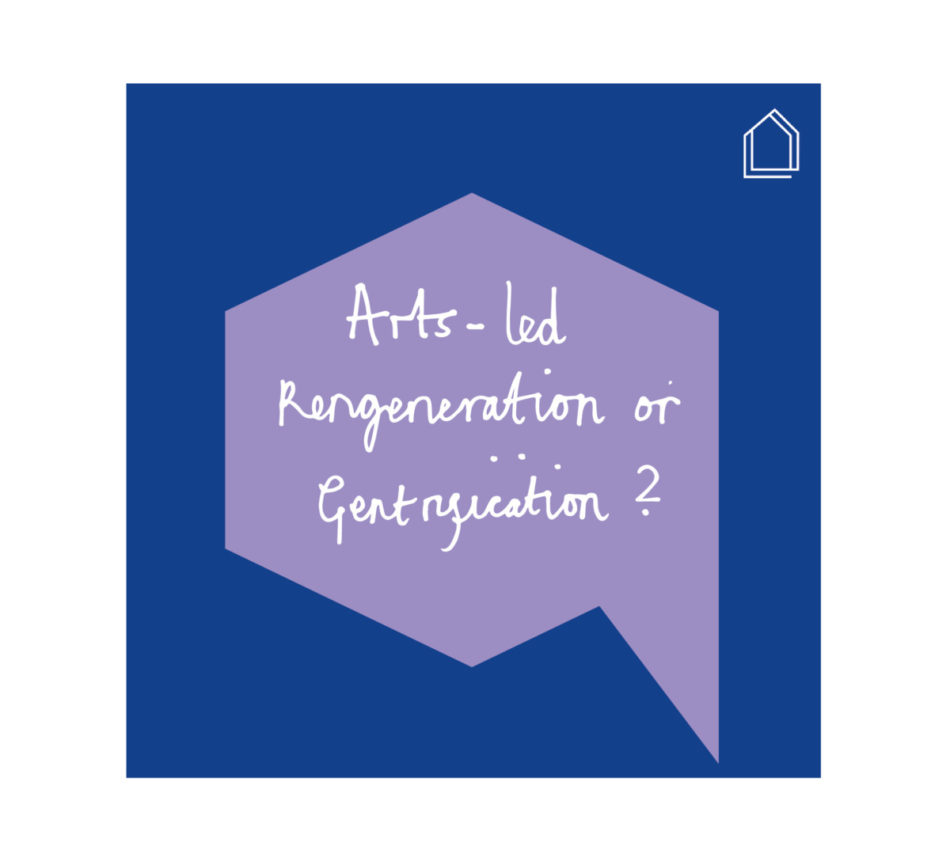Written by:
Over the past few decades, art has become an increasingly popular mechanism for transforming places, whether led by an individual or collective, or as part of informal or formal placemaking processes. In this Chat, Arts-led Regeneration or Gentrification? we explored the role of arts-led placemaking as a tool for social, cultural, and physical change in the places where we live, work and play. As with most of our Chats, we were joined by a small but diverse audience including architects, urbanists, students and socially engaged organisations.
Key Themes
We began by considering the power of art to transform the way we see the city, with our Chat participants suggesting that integrating arts-led activities into the context of placemaking invites us to rediscover the places we are familiar with through a new lens. The conversation moved towards discussing the degrees of formality involved in arts-led placemaking and the inherent power differences depending on who leads the process (contemplating the narrative of regeneration versus gentrification). Finally, we explored the value of the arts-led process, as well as the value of those artists who are delivering the placemaking initiatives.
The transformative power of art (rediscovering place)
While The Glass-House is not a traditional arts-led organisation, we value the role of the arts as well as design in catalysing conversations about place. We often use making to introduce groups to design concepts and thinking, and to help connect them with their places through design.
There is a certain power in the arts to invite people into spaces of rediscovery. Arts-led placemaking can act as a catalyst for thinking differently about the places where we live, work and play, as well as opening up discussion around our likes and dislikes. It can act as a tool to invite those in the community to articulate their ideas about their neighbourhood and to contribute to shifting power over who is able to convene and shape conversations about place.
Play and risk emerged as an important facet of the built environment in encouraging us to think differently about how we interact with the city. Inviting play into the city as a placemaking lens is important for all generations and we discussed how public art can both become a vehicle for exploring play and can contribute to playable landscapes.
Rediscovery and transformation are also closely intertwined with using our imagination. The arts can help us connect with, celebrate and articulate our heritage and traditions, and imagine possible futures. This creates a mechanism to both use and influence the city differently, through linking place to its people, history and traditions.
When does arts-led placemaking become gentrification?
While recognising the power of the arts to transform spaces and places through small, and bottom-up initiatives, ironically, this can also lead to areas being identified as ‘up-and-coming’ and to them becoming targeted for more formal and larger-scale regeneration initiatives. Even when arts-led generation is built into these plans, formalising the process can both change its dynamic and shift power away from the very communities who initiated change in the area.
So, we recognised that arts-led placemaking can operate at multiple scales and speeds. Informal arts-led placemaking could be considered a bottom-up approach, one that works with members of the community organically creating routes into the arts and culture in general, but also one in which they affect or are part of catalysing change in a place. More formal avenues of arts-led placemaking could be derived from initiatives led by a local authority or developer, such as through boroughs / Cities of Culture. These can provide much needed support for catalysing arts and culture in cities, but what happens when the funding runs out?
It’s hard to ignore the current lack of funding for the arts, and the challenges that locally driven initiatives and arts-led processes face in the current landscape of austerity and the cost of living crisis.
Protecting arts-led processes
At a local scale, arts-led placemaking can also create greater accessibility into the arts. A way to protect the arts and arts-led placemaking is to understand the value it brings in creating accessible routes into participation, articulating opinions, and breaking down silos within the built environment.
As a group we tried to identify the reasons why we as a country tend to undervalue the arts. Is the lack of funding for arts-led activities an indication of the lack of value we place on the arts and artists in society as a whole? Why is that? Art in all its forms can sometimes be considered elitist, a result, for example, of the cost of theatre tickets, or due to the institutional façade of gallery spaces that can often feel imposing and neither accessible nor welcoming to some people. These things can impose both physical and emotional barriers around access to arts and culture.
Is our perception of the arts, and the value we place on the arts and artists a result of our educational institutions undervaluing arts and creating more visibility for STEM subjects? Is it because, as we move into adulthood, arts-led methodologies, design and making as tools for learning become less utilised?
Does this combination of issues also create an unconscious process of devaluing arts-based professions and creative spaces as we move from children to adulthood in our society?
The golden thread
A constant thread throughout the conversation was the power of arts-led placemaking to provide routes into both rediscovering the city, and into arts and culture for underrepresented groups. Ultimately that level of accessibility is about inviting and doing with, not to people, and with the right support and partnership working, the arts and artists can help create these inclusive opportunities for diverse people to shape the places where they live, work and play.


